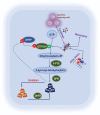Oxidative Stress, GTPCH1, and Endothelial Nitric Oxide Synthase Uncoupling in Hypertension
- PMID: 32363908
- PMCID: PMC7910417
- DOI: 10.1089/ars.2020.8112
Oxidative Stress, GTPCH1, and Endothelial Nitric Oxide Synthase Uncoupling in Hypertension
Abstract
Significance: Hypertension has major health consequences, which is associated with endothelial dysfunction. Endothelial nitric oxide synthase (eNOS)-produced nitric oxide (NO) signaling in the vasculature plays an important role in maintaining vascular homeostasis. Considering the importance of NO system, this review aims to provide a brief overview of the biochemistry of members of NO signaling, including GTPCH1 [guanosine 5'-triphosphate (GTP) cyclohydrolase 1], tetrahydrobiopterin (BH4), and eNOS. Recent Advances: Being NO signaling activators and regulators of eNOS signaling, BH4 treatment is getting widespread attention either as potential therapeutic agents or as preventive agents. Recent clinical trials also support that BH4 treatment could be considered a promising therapeutic in hypertension. Critical Issues: Under conditions of BH4 depletion, eNOS-generated superoxides trigger pathological events. Abnormalities in NO availability and BH4 deficiency lead to disturbed redox regulation causing pathological events. This disturbed signaling influences the development of systemic hypertension as well as pulmonary hypertension. Future Directions: Considering the importance of BH4 and NO to improve the translational significance, it is essential to continue research on this field to manipulate BH4 to increase the efficacy for treating hypertension. Thus, this review also examines the current state of knowledge on the effects of eNOS activators on preclinical models and humans to utilize this information for potential therapy.
Keywords: GTPCH1; eNOS uncoupling; endothelial nitric oxide synthase; hypertension.
Figures






Similar articles
-
Tetrahydrobiopterin recycling, a key determinant of endothelial nitric-oxide synthase-dependent signaling pathways in cultured vascular endothelial cells.J Biol Chem. 2009 May 8;284(19):12691-700. doi: 10.1074/jbc.M809295200. Epub 2009 Mar 12. J Biol Chem. 2009. PMID: 19286667 Free PMC article.
-
Acute inhibition of guanosine triphosphate cyclohydrolase 1 uncouples endothelial nitric oxide synthase and elevates blood pressure.Hypertension. 2008 Sep;52(3):484-90. doi: 10.1161/HYPERTENSIONAHA.108.112094. Epub 2008 Jul 21. Hypertension. 2008. PMID: 18645049 Free PMC article.
-
Critical role for tetrahydrobiopterin recycling by dihydrofolate reductase in regulation of endothelial nitric-oxide synthase coupling: relative importance of the de novo biopterin synthesis versus salvage pathways.J Biol Chem. 2009 Oct 9;284(41):28128-28136. doi: 10.1074/jbc.M109.041483. Epub 2009 Aug 7. J Biol Chem. 2009. PMID: 19666465 Free PMC article.
-
Regulation of endothelial nitric oxide synthase by tetrahydrobiopterin in vascular disease.Arterioscler Thromb Vasc Biol. 2004 Mar;24(3):413-20. doi: 10.1161/01.ATV.0000110785.96039.f6. Epub 2003 Dec 4. Arterioscler Thromb Vasc Biol. 2004. PMID: 14656731 Review.
-
Mechanisms and consequences of endothelial nitric oxide synthase dysfunction in hypertension.J Hypertens. 2015 Jun;33(6):1128-36. doi: 10.1097/HJH.0000000000000587. J Hypertens. 2015. PMID: 25882860 Free PMC article. Review.
Cited by
-
Chrysin attenuates high-fat-diet-induced myocardial oxidative stress via upregulating eNOS and Nrf2 target genes in rats.Mol Cell Biochem. 2021 Jul;476(7):2719-2727. doi: 10.1007/s11010-021-04105-5. Epub 2021 Mar 7. Mol Cell Biochem. 2021. PMID: 33677805
-
The Role of Oxidants in Percutaneous Coronary Intervention-Induced Endothelial Dysfunction: Can We Harness Redox Signaling to Improve Clinical Outcomes?Antioxid Redox Signal. 2023 May;38(13-15):1022-1040. doi: 10.1089/ars.2022.0204. Epub 2023 Mar 7. Antioxid Redox Signal. 2023. PMID: 36641638 Free PMC article. Review.
-
Enhanced external counterpulsation improves dysfunction of forearm muscle caused by radial artery occlusion.Front Cardiovasc Med. 2023 Mar 2;10:1115494. doi: 10.3389/fcvm.2023.1115494. eCollection 2023. Front Cardiovasc Med. 2023. PMID: 36937941 Free PMC article.
-
Resveratrol and vascular health: evidence from clinical studies and mechanisms of actions related to its metabolites produced by gut microbiota.Front Pharmacol. 2024 Mar 18;15:1368949. doi: 10.3389/fphar.2024.1368949. eCollection 2024. Front Pharmacol. 2024. PMID: 38562461 Free PMC article. Review.
-
Citronellal improves endothelial dysfunction by affecting the stability of the GCH1 protein.Acta Biochim Biophys Sin (Shanghai). 2024 Jun 3;56(7):963-972. doi: 10.3724/abbs.2024086. Acta Biochim Biophys Sin (Shanghai). 2024. PMID: 38993132 Free PMC article.
References
-
- Almudever P, Milara J, De Diego A, Serrano-Mollar A, Xaubet A, Perez-Vizcaino F, Cogolludo A, and Cortijo J. Role of tetrahydrobiopterin in pulmonary vascular remodelling associated with pulmonary fibrosis. Thorax 68: 938–948, 2013 - PubMed
-
- Alp NJ and Channon KM. Regulation of endothelial nitric oxide synthase by tetrahydrobiopterin in vascular disease. Arterioscler Thromb Vasc Biol 24: 413–420, 2004 - PubMed
-
- Alp NJ, McAteer MA, Khoo J, Choudhury RP, and Channon KM. Increased endothelial tetrahydrobiopterin synthesis by targeted transgenic GTP-cyclohydrolase I overexpression reduces endothelial dysfunction and atherosclerosis in ApoE-knockout mice. Arterioscler Thromb Vasc Biol 24: 445–450, 2004 - PubMed
-
- An H, Wei R, Ke J, Yang J, Liu Y, Wang X, Wang G, and Hong T. Metformin attenuates fluctuating glucose-induced endothelial dysfunction through enhancing GTPCH1-mediated eNOS recoupling and inhibiting NADPH oxidase. J Diabetes Complications 30: 1017–1024, 2016 - PubMed
Publication types
MeSH terms
Substances
LinkOut - more resources
Full Text Sources
Other Literature Sources
Medical

